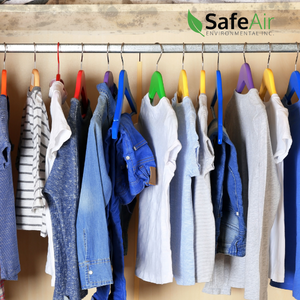What Are Your Clothes Telling You About Mold in Your Home?
Posted in Mold, on October 13, 2022
We’ve all heard stories about mold growth in homes — you may have even had a mold inspection in Toronto. Many folks don’t make the connection between mold growth and air quality testing, but at SafeAir, the results are clear: mold spores are commonly found floating in the atmosphere of our home. But have you ever thought about how mold got into your home in the first place? One of the ways mold finds its way into our indoor air quality is by hitching a ride on our backs — literally!
How Does Mold Attach to Clothes?
 Most people understand that mold grows primarily on organic materials like wood, drywall, or paper. But soft porous textiles are one of the materials most affected by mold growth. Some of the household textiles that can be affected by mold include:
Most people understand that mold grows primarily on organic materials like wood, drywall, or paper. But soft porous textiles are one of the materials most affected by mold growth. Some of the household textiles that can be affected by mold include:
- Sofas and upholstered chairs
- Rugs and carpets
- Drapes and window dressing
- Clothes
- Shoes and boots
How does the mold get there in the first place? Mold attaches to your clothes through contact with mold spores, either inside your home or during your workday. Textiles are frequently affected by mold growth because they are wholly or partially made from organic materials (which mold eats), or they hold onto moisture or take a long time to dry out (such as in the case of thick rugs, down coats, or upholstered items). All mold really needs to start growing is water and a food source.
What Kind of Mold Grows on Clothes?
Mold is a diverse fungus with thousands of species that usually. The mold typically detected by mold testing and inspection services like SafeAir is Aspergillus, but the truth is that many different types of mold grow on clothes, and the variety is less important than identifying the conditions that caused the mold in the first place.
How to Identify Mold On Clothes
Identifying mold spores latched onto your clothes can stop infestations from incurring with your residential or commercial property to begin with. While it’s just as important to address the conditions that contribute to mold infestation, knowing where they’re coming from can help you put a stop to the mold.
Clothes affected by mold growth may:
- Smell musty or damp
- Have a film of white, green, black, or coloured powder
- Feel slick or wet
- Feel heavy or crunchy
- Look discoloured or stained
How to Prevent Mold on Clothes
Air quality testing and air quality safety are deeply connected. Healthy indoor air quality starts with prevention, and keeping your clothing mold free starts with a few easy habits:
- Put your clothes away dry: Don’t shove a wet coat into a cupboard or fold damp clothes into a drawer.
- Put things away clean: At the end of a season, launder or clean off coats, boots, shoes, and other gear to prevent any mold spores from taking hold while they’re stowed in the basement or attic for a few months.
- Air out your cupboards: Does putting your clothes into the wardrobe feel like a jigsaw puzzle? If your closet is stuffed, air movement that keeps mold at bay ceases — a seasonal clear-out and vacuum helps prevent mold (and clothes moths too!).
Preventing Mold on Clothes with SafeAir
If you’re worried about mold affecting any part of your home, a mold inspection in Toronto can help you get to the bottom of it. SafeAir’s whole-home inspection service takes a comprehensive look at your indoor environment and will help you uncover hidden mold growth or factors that put you at risk.

